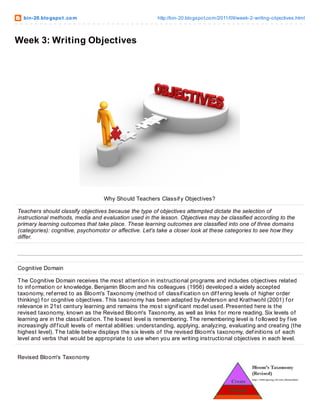
Why should teachers classify objectives
- 1. bin-20.blogspot .com http://bin-20.blogspot.com/2011/09/week-2-writing-objectives.html Week 3: Writing Objectives Why Should Teachers Classif y Objectives? Teachers should classify objectives because the type of objectives attempted dictate the selection of instructional methods, media and evaluation used in the lesson. Objectives may be classified according to the primary learning outcomes that take place. These learning outcomes are classified into one of three domains (categories): cognitive, psychomotor or affective. Let's take a closer look at these categories to see how they differ. Cognitive Domain The Cognitive Domain receives the most attention in instructional programs and includes objectives related to inf ormation or knowledge. Benjamin Bloom and his colleagues (1956) developed a widely accepted taxonomy, ref erred to as Bloom's Taxonomy (method of classif ication on dif f ering levels of higher order thinking) f or cognitive objectives. This taxonomy has been adapted by Anderson and Krathwohl (2001) f or relevance in 21st century learning and remains the most signif icant model used. Presented here is the revised taxonomy, known as the Revised Bloom's Taxonomy, as well as links f or more reading. Six levels of learning are in the classif ication. The lowest level is remembering. The remembering level is f ollowed by f ive increasingly dif f icult levels of mental abilities: understanding, applying, analyzing, evaluating and creating (the highest level). The table below displays the six levels of the revised Bloom's taxonomy, def initions of each level and verbs that would be appropriate to use when you are writing instructional objectives in each level. Revised Bloom's Taxonomy
- 2. Remembering Objectives written on the remembering level (the lowest cognitive level) requires the student to recall or recognize specif ic inf ormation. Below are verbs appropriate f or objectives written at the remembering level. def ine f ill in the blank identif y label list locate match memorize name recall spell state tell underline state Understanding Objectives written on the understanding level, although a higher level of mental ability than remembering, requires the lowest level of understanding f rom the student. Below are verbs appropriate f or objectives written at the understanding level. convert describe explain interpret paraphrase put in order restate retell in your words rewrite summarize trace translate Applying Objectives written on the applying level require the learner to implement (use) the inf ormation. Below are verbs appropriate f or objectives written at the applying level. apply compute conclude construct demonstrate determine draw f ind out give an example illustrate make operate show solve state a rule or principle use Analysing Objectives written on the analysing level require the learner to break the inf ormation into component parts and describe the relationship. Below are verbs appropriate f or objectives written at the analysing level. analyze categorize classif y compare contrast debate deduct determine the f actors diagnose diagram dif f erentiate dissect distinguish examine inf er specif y
- 3. Evaluating Objectives written on the evaluating level require the student to make a judgment about materials or methods. Below are verbs appropriate f or objectives written at the evaluating level. appraise choose compare conclude decide def end evaluate give your opinion judge justif y prioritize rank rate select support value Creating Objectives written on the creating level require the student to generate new ideas, products and ways of viewing things. Below are verbs appropriate f or objectives written at the creating level. change combine compose construct create design f ind an unusual way f ormulate generate invent originate plan predict pretend produce rearrange reconstruct reorganize revise suggest suppose visualize write Psychomotor Domain The Psychomotor Domain includes objectives that require basic motor skills and/or physical movement such as construct, kick or ski. Af f ective Domain The Af f ective Domain includes objectives pertaining to attitudes, appreciations, values and emotions.
